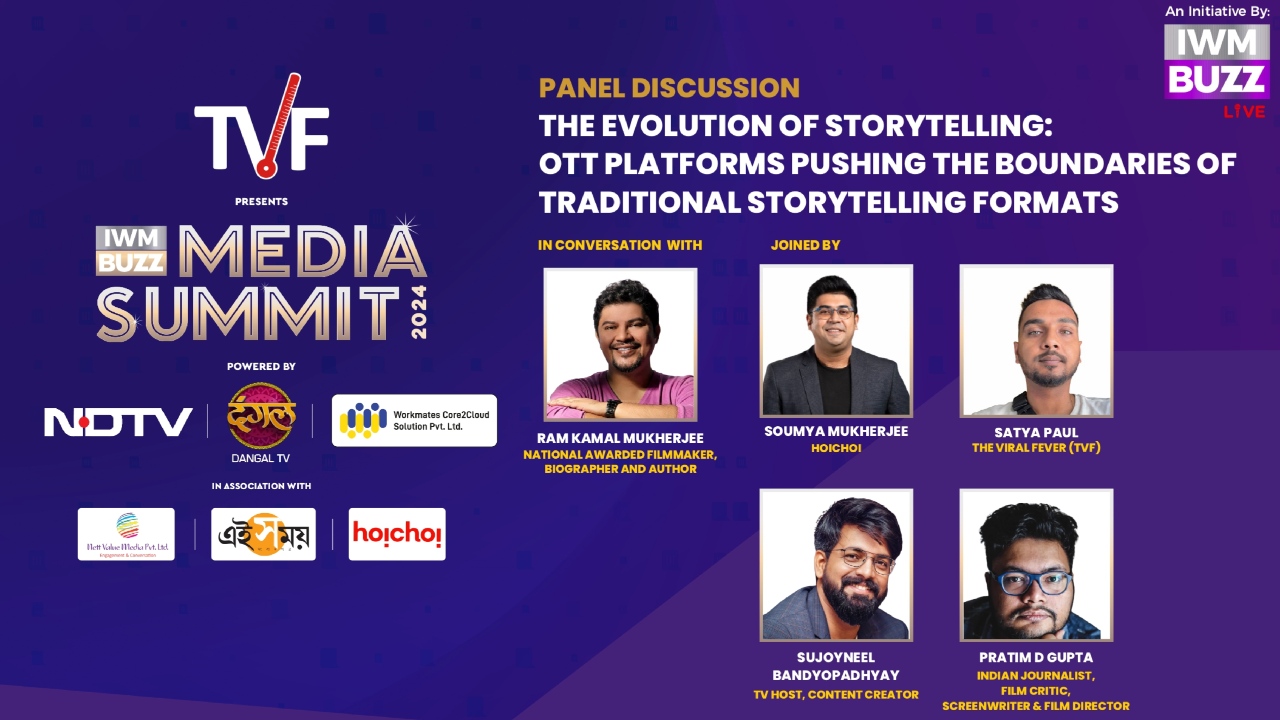The Indian media landscape has experienced a profound transformation over the past decade. From the rapid rise of OTT platforms to the disruptive influence of AI and influencer marketing, the lines between content creation and consumption have become increasingly indistinct. The IWMBuzz Media Summit 2024, held in the vibrant city of Kolkata, served as a gathering point for industry leaders to delve into these sweeping changes. At the core of the summit was a compelling panel discussion titled The Evolution of Storytelling: OTT Platforms Pushing the Boundaries of Traditional Narratives, moderated by the esteemed filmmaker and author, Ram Kamal Mukherjee.
Setting the Stage
The panel was a powerhouse of creative thinkers: Soumya Mukherjee (COO, Hoichoi), Satya Paul (Head of Brand Solutions, TVF), Sujoyneel Bandyopadhyay (TV host and content creator), and Pratim D. Gupta (renowned journalist and filmmaker). Their discussion peeled back the layers of what storytelling means in an age where content is king but attention spans are fleeting.
OTT platforms are fundamentally changing how stories are told, offering more freedom and flexibility than traditional media ever could. Without the constraints of time slots or rigid formats, creators now have the freedom to develop complex characters and intricate plots, often with deeper emotional and thematic exploration. This has led to a rise in long-form storytelling, where narratives can unfold at their own pace. Additionally, OTT platforms have provided a global stage for regional content, enabling diverse voices and cultures to reach wider audiences. By breaking down traditional barriers, OTT has created a space for more authentic, innovative, and boundary-pushing stories that appeal to a broader, more diverse audience.
So, are OTT platforms bridging the gap or carving new paths?
The debate started with Soumya Mukherjee highlighting how regional OTT platforms like Hoichoi embrace India’s linguistic diversity to reach audiences far beyond the metropolitan hubs. “We’re not just an extension of TV content,” Mukherjee asserted. “Our approach is hyper-local yet global, catering to a massive audience while staying true to our cultural roots.”
In contrast, Satya Paul shed light on TVF’s unique strategy, which defies the conventional star system. “For us, storytelling begins in the writer’s room. It’s not about big names but strong narratives. The writer is the real star,” Paul emphasised, striking a chord with those in attendance.
The Creator’s Dilemma: Content vs. Commerce
The conversation took a deeper dive, with Pratim D. Gupta asserting creators’ challenges. “In cinema, the star sells the story. In OTT, the story must sell itself,” he said, reflecting on the evolving audience dynamics. Gupta also pointed out the delicate balance between crafting compelling content and meeting commercial imperatives in a fiercely competitive market.
Does franchise work? – Longevity in a crowded space
Satya Paul introduced an intriguing perspective on the longevity of OTT content. “The key lies in building memorable characters and story arcs that can evolve into franchises,” he said. Highlighting aspirational series like Aspirants, Satya mentioned how Aspirants had no buyers, and therefore, TVF decided to release it on its own YouTube channel, and the rest, the audience decided. He noted that the story needs ‘depth to survive 5 seasons.’
But in the chaos of the crowd, how important is it for the creator to pull the crowd? Ram Kamal Mukherjee throws the penultimate question. Sujoyneel Bandyopadhyay lures applause as he says, “Creators who make content to become viral never sustain, but someone who makes content to inspire the crowd will always be loved and respected.”
The discussion also explored how technology enhances storytelling while posing unique challenges. Soumya noted, “Tech can amplify a story but never replace the creator’s thought process. The magic still starts in the writer’s room.” His insight was a gentle reminder that while AI and algorithms shape recommendations, the soul of a story remains human.
Budget, however, plays a role. Pratik says “Before the draft is done, the budget is decided.” He adds that someone who has managed to make a film in Kolkata, being infamous for a budget crunch, can make any film given any budget. He says ‘if you can drive an ambassador, you can drive any car.” Satya rightly says, ‘No budget is sufficient budget. However, it challenges creativity time and again.”
Closing Thoughts: A New Dawn for Indian Media
The panel ended on an optimistic note, with Mukherjee summarising the essence of the discussion: “OTT platforms are reshaping creative boundaries. The Indian media industry is poised for a renaissance, driven by innovation, inclusivity, and bold narratives.”
As the IWMBuzz Media Summit 2024 concluded, one thing became abundantly clear: the future of storytelling in India is limitless. With platforms like Hoichoi, TVF, and others leading the charge, the stage is set for narratives that are not just engaging but transformative. In this evolving landscape, creators and platforms alike are redefining what it means to tell a story.
Title Partner: TVF
Powered by: NDTV | Dangal TV | Workmates Core2Cloud Solution Pvt. Ltd.
In Association with: Nett Value Media Pvt. Ltd. | Ei Samay | Hoichoi
Partners: Taarak Mehta Ka Ooltah Chashmah Rhymes | Redington Limited | White Frames | Just Lateral ThinkInk | Celebistaan | Decalogue
Watch the full video below:

